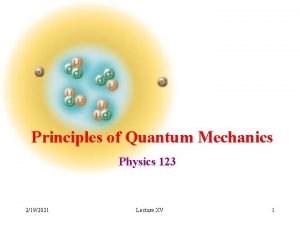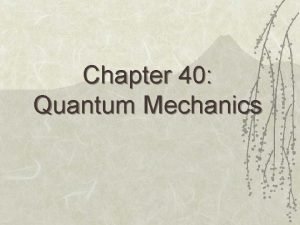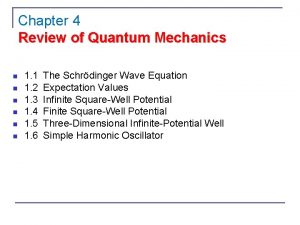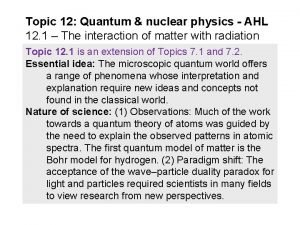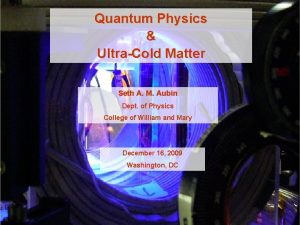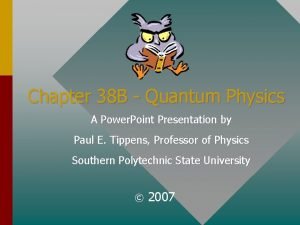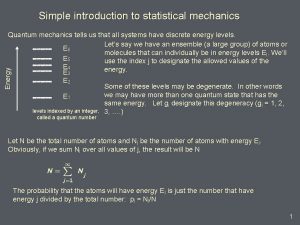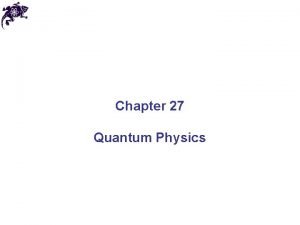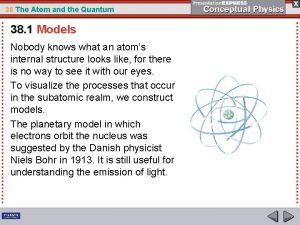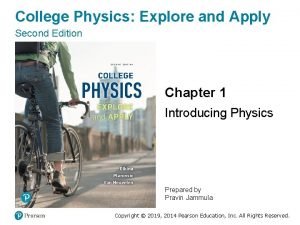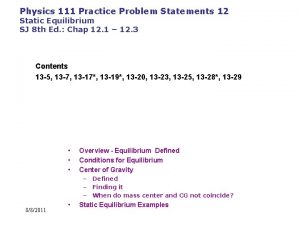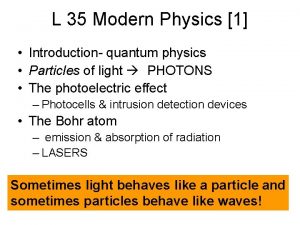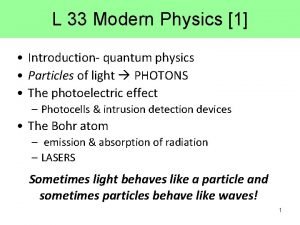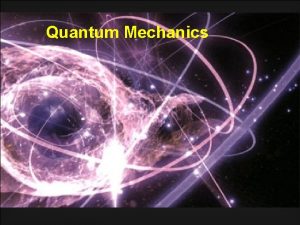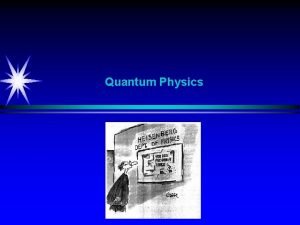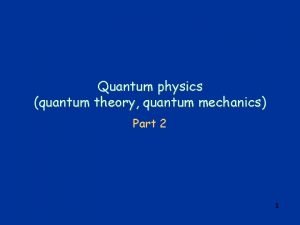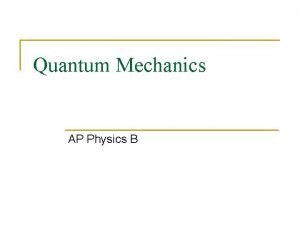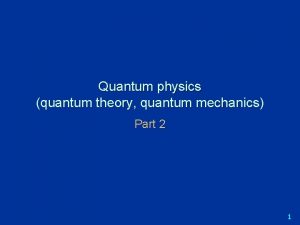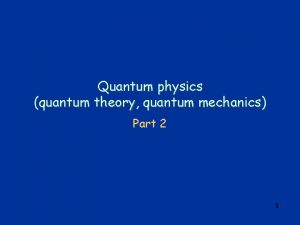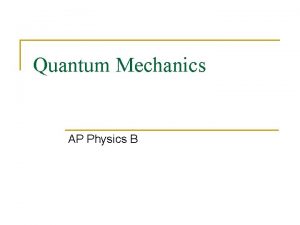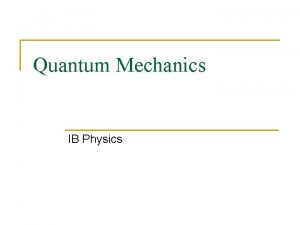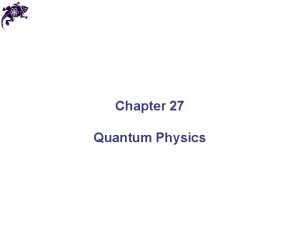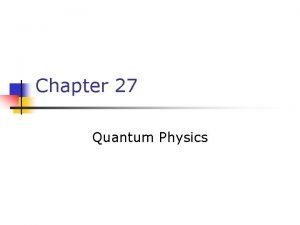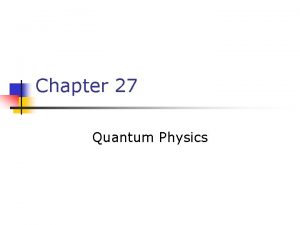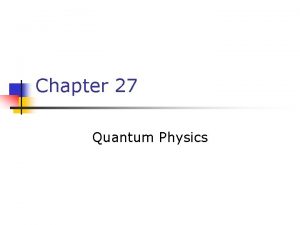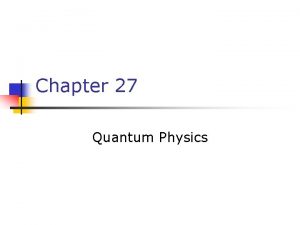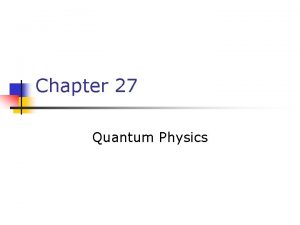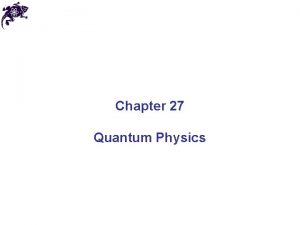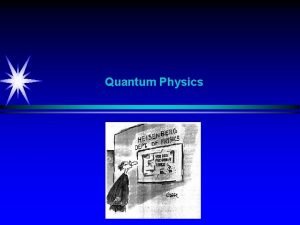COLLEGE PHYSICS Chapter 29 INTRODUCTION TO QUANTUM PHYSICS



























- Slides: 27

COLLEGE PHYSICS Chapter 29 INTRODUCTION TO QUANTUM PHYSICS Power. Point Image Slideshow

FIGURE 29. 1 A black fly imaged by an electron microscope is as monstrous as any science-fiction creature. (credit: U. S. Department of Agriculture via Wikimedia Commons)

FIGURE 29. 2 Atoms and their substructure are familiar examples of objects that require quantum mechanics to be fully explained. Certain of their characteristics, such as the discrete electron shells, are classical physics explanations. In quantum mechanics we conceptualize discrete “electron clouds” around the nucleus.

FIGURE 29. 3 Graphs of blackbody radiation (from an ideal radiator) at three different radiator temperatures. The intensity or rate of radiation emission increases dramatically with temperature, and the peak of the spectrum shifts toward the visible and ultraviolet parts of the spectrum. The shape of the spectrum cannot be described with classical physics.

FIGURE 29. 4 The German physicist Max Planck had a major influence on the early development of quantum mechanics, being the first to recognize that energy is sometimes quantized. Planck also made important contributions to special relativity and classical physics. (credit: Library of Congress, Prints and Photographs Division via Wikimedia Commons)

FIGURE 29. 5 Emission spectrum of oxygen. When an electrical discharge is passed through a substance, its atoms and molecules absorb energy, which is reemitted as EM radiation. The discrete nature of these emissions implies that the energy states of the atoms and molecules are quantized. Such atomic spectra were used as analytical tools for many decades before it was understood why they are quantized. (credit: Teravolt, Wikimedia Commons)

FIGURE 29. 7 The photoelectric effect can be observed by allowing light to fall on the metal plate in this evacuated tube. Electrons ejected by the light are collected on the collector wire and measured as a current. A retarding voltage between the collector wire and plate can then be adjusted so as to determine the energy of the ejected electrons. For example, if it is sufficiently negative, no electrons will reach the wire. (credit: P. P. Urone)

FIGURE 29. 8 An EM wave of frequency f is composed of photons, or individual quanta of EM radiation. The energy of each photon is E = hf , where h is Planck’s constant and f is the frequency of the EM radiation. Higher intensity means more photons per unit area. The flashlight emits large numbers of photons of many different frequencies, hence others have energy E′ = hf ′ , and so on.

FIGURE 29. 9

FIGURE 29. 11 The EM spectrum, showing major categories as a function of photon energy in e. V, as well as wavelength and frequency. Certain characteristics of EM radiation are directly attributable to photon energy alone.

FIGURE 29. 12 One of the first x-ray images, taken by Röentgen himself. The hand belongs to Bertha Röentgen, his wife. (credit: Wilhelm Conrad Röntgen, via Wikimedia Commons)

FIGURE 29. 13 X rays are produced when energetic electrons strike the copper anode of this cathode ray tube (CRT). Electrons (shown here as separate particles) interact individually with the material they strike, sometimes producing photons of EM radiation.

FIGURE 29. 14 X-ray spectrum obtained when energetic electrons strike a material. The smooth part of the spectrum is bremsstrahlung, while the peaks are characteristic of the anode material. Both are atomic processes that produce energetic photons known as x-ray photons.

FIGURE 29. 15 Why do the reds, yellows, and greens fade before the blues and violets when exposed to the Sun, as with this poster? The answer is related to photon energy. (credit: Deb Collins, Flickr)

FIGURE 29. 17 The tails of the Hale-Bopp comet point away from the Sun, evidence that light has momentum. Dust emanating from the body of the comet forms this tail. Particles of dust are pushed away from the Sun by light reflecting from them. The blue ionized gas tail is also produced by photons interacting with atoms in the comet material. (credit: Geoff Chester, U. S. Navy, via Wikimedia Commons)

FIGURE 29. 18 The Compton effect is the name given to the scattering of a photon by an electron. Energy and momentum are conserved, resulting in a reduction of both for the scattered photon. Studying this effect, Compton verified that photons have momentum.

FIGURE 29. 19 (a) Space sails have been proposed that use the momentum of sunlight reflecting from gigantic low -mass sails to propel spacecraft about the solar system. A Russian test model of this (the Cosmos 1) was launched in 2005, but did not make it into orbit due to a rocket failure. (b) A U. S. version of this, labeled Light. Sail-1, is scheduled for trial launches in the first part of this decade. It will have a 40 -m 2 sail. (credit: Kim Newton/NASA)

FIGURE 29. 20 (a) The interference pattern for light through a double slit is a wave property understood by analogy to water waves. (b) The properties of photons having quantized energy and momentum and acting as a concentrated unit are understood by analogy to macroscopic particles.

FIGURE 29. 22 This diffraction pattern was obtained for electrons diffracted by crystalline silicon. Bright regions are those of constructive interference, while dark regions are those of destructive interference. (credit: Ndthe, Wikimedia Commons)

FIGURE 29. 23 Schematic of a scanning electron microscope (SEM) (a) used to observe small details, such as those seen in this image of a tooth of a Himipristis, a type of shark (b). (credit: Dallas Krentzel, Flickr)

FIGURE 29. 24 The diffraction pattern at top left is produced by scattering electrons from a crystal and is graphed as a function of incident angle relative to the regular array of atoms in a crystal, as shown at bottom. Electrons scattering from the second layer of atoms travel farther than those scattered from the top layer. If the path length difference (PLD) is an integral wavelength, there is constructive interference.

FIGURE 29. 25 The building up of the diffraction pattern of electrons scattered from a crystal surface. Each electron arrives at a definite location, which cannot be precisely predicted. The overall distribution shown at the bottom can be predicted as the diffraction of waves having the de Broglie wavelength of the electrons.

FIGURE 29. 26 Double-slit interference for electrons (a) and photons (b) is identical for equal wavelengths and equal slit separations. Both patterns are probability distributions in the sense that they are built up by individual particles traversing the apparatus, the paths of which are not individually predictable.

FIGURE 29. 27 Werner Heisenberg was one of the best of those physicists who developed early quantum mechanics. Not only did his work enable a description of nature on the very small scale, it also changed our view of the availability of knowledge. Although he is universally recognized for his brilliance and the importance of his work (he received the Nobel Prize in 1932, for example), Heisenberg remained in Germany during World War II and headed the German effort to build a nuclear bomb, permanently alienating himself from most of the scientific community. (credit: Author Unknown, via Wikimedia Commons)

FIGURE 29. 28 On a quantum-mechanical scale (i. e. , very small), particles with and without mass have wave properties. For example, both electrons and photons have wavelengths but also behave as particles.

FIGURE 29. 29 On a classical scale (macroscopic), particles with mass behave as particles and not as waves. Particles without mass act as waves and not as particles.

This Power. Point file is copyright 2011 -2013, Rice University. All Rights Reserved.
 Origin of quantum mechanics
Origin of quantum mechanics Quantum physics vs mechanics
Quantum physics vs mechanics Physics topic 12
Physics topic 12 Quantum physics wave function
Quantum physics wave function Quantum numbers khan academy
Quantum numbers khan academy Ap quantum physics
Ap quantum physics Quantum physics wave function
Quantum physics wave function Quantum physics wave function
Quantum physics wave function Quantum nuclear physics
Quantum nuclear physics Seth aubin
Seth aubin Electron volt to volt
Electron volt to volt Quantum physics in hindi
Quantum physics in hindi Introduction to quantum statistical mechanics
Introduction to quantum statistical mechanics Physics chapter 1 introduction and mathematical concepts
Physics chapter 1 introduction and mathematical concepts Chapter 27 quantum theory answers
Chapter 27 quantum theory answers Chapter 38 the atom and the quantum
Chapter 38 the atom and the quantum Wake tech admissions
Wake tech admissions Early college high school at midland college
Early college high school at midland college College physics: explore and apply answers
College physics: explore and apply answers Excelsior college basic genetics
Excelsior college basic genetics College essay introduction
College essay introduction Apa format rasmussen
Apa format rasmussen Why does it happen
Why does it happen University physics with modern physics fifteenth edition
University physics with modern physics fifteenth edition Linkedin
Linkedin Introduction to static equilibrium mastering physics
Introduction to static equilibrium mastering physics Modern physics introduction
Modern physics introduction Modern physics introduction
Modern physics introduction



